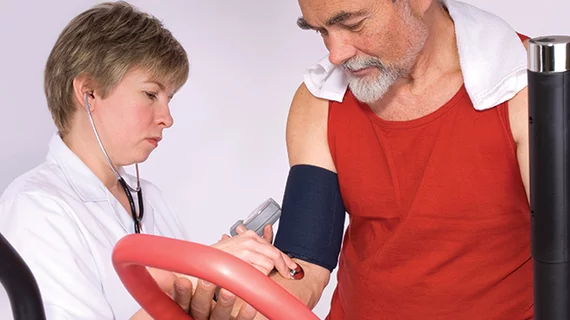The “often overlooked” strategy of stress echocardiography outperformed coronary CT angiography (CTA) in a randomized trial of low to intermediate-risk patients with acute chest pain, resulting in fewer hospitalizations, shorter stays and similar midrange safety outcomes.
CTA is increasingly replacing functional testing in emergency departments, the authors noted, partially because it can be performed quicker. But it carries a list of concerns including radiation exposure and incidental findings which may lead to overdiagnoses or increased revascularizations of “uncertain” value, lead author Jeffrey M. Levsky, MD, PhD, and colleagues wrote in JACC: Cardiovascular Imaging.
To investigate the efficiency and safety of CTA versus stress echocardiography (SE), the researchers randomized 400 patients from a medical center in the Bronx, New York, 1:1 to either test. All patients had no known coronary artery disease and a negative initial serum troponin level, as well as resolved chest pain before undergoing imaging.
Unlike most cardiovascular trials, the patients were predominantly Hispanic (46 percent) or black (32 percent) and their average age was 55.
Levsky et al. found:
- 19 percent of CTA patients were hospitalized compared to 11 percent of SE patients.
- Among patients who were discharged, median length of stay in the emergency department (ED) was 5.4 hours for coronary CTA and 4.7 hours for SE.
- Admitted patients spent a median 58 hours in the hospital with CTA and 34 hours with SE.
- The number of major adverse cardiovascular events after two years of follow-up was 11 and 7, respectively, for CTA and SE—a statistically nonsignificant difference.
- Patients undergoing CTA were more likely to be prescribed beta-blocker or lipid-lowering medication. While both groups had seven patients who later underwent percutaneous coronary intervention, there was a nonsignificant trend toward more coronary artery bypass graft (CABG) surgeries in the CTA group (4 versus 0).
“SE is a safe and effective triage method for acutely symptomatic ED chest pain patients that has the potential to reduce hospital admission, length of stay, and radiation exposure,” Levsky et al. wrote. “Further studies are needed to elucidate the best respective roles for the available imaging modalities and when imaging might safely be avoided in ED chest pain triage.”
The authors pointed out their findings are in contrast with previous randomized trials, all of which showed a decreased length of stay with coronary CTA compared to standard care.
“This is most likely the direct result of performing coronary CTA earlier in the diagnostic algorithm than standard care noninvasive testing,” they wrote. “In our study, coronary CTA and SE were performed at the same point in the diagnostic work-up and recruited patients during weekday, daytime hours, which differs from some practices.”
Levsky and colleagues noted patients treated in “off hours” might have longer lengths of stay due to fewer experts being readily available to interpret test results. In addition, the clinicians used conventional troponin assays rather than high-sensitivity assays, which weren’t available at their institution. Use of the newer biomarker test may have prevented more patients from requiring any imaging, the researchers noted.
The patient cohort was relatively low-risk, the authors reiterated, so more work must be done to clarify the appropriate imaging approach for different situations. Each method has its strengths and weaknesses—and even some of the “positive” comparative results for SE don’t reflect unfavorably on the more sensitive coronary CTA test, according to the authors of an accompanying editorial.
“More patients receiving coronary CTA were hospitalized for noncardiac causes than those evaluated with stress echocardiography, likely because the rate of incidental findings is higher with coronary CTA than with stress echocardiography; however, this is not necessarily a disadvantage,” wrote Pamela S. Douglas, MD, and Melissa A. Daubert, MD, both with Duke Clinical Research Institute. “Second, coronary CTA can detect both obstructive and nonobstructive CAD, but stress echocardiography would be expectedly negative in patients without functionally significant stenoses, even though they could still have underlying CAD.”
The editorialists said it may be impossible to identify one test that is best for evaluating all patients with acute chest pain. The goals of testing, operator expertise and patient risk factors, preference and safety should all play a role in test selection.
“As medicine moves away from a one-size-fits-all approach to one characterized by personalized decision making based on multiple data sources, perhaps imaging should follow suit,” Douglas and Daubert wrote. “To do this, we need to move past the polarizing and overly simplistic anatomic versus functional debate to develop and adopt the principles of precision testing.”

